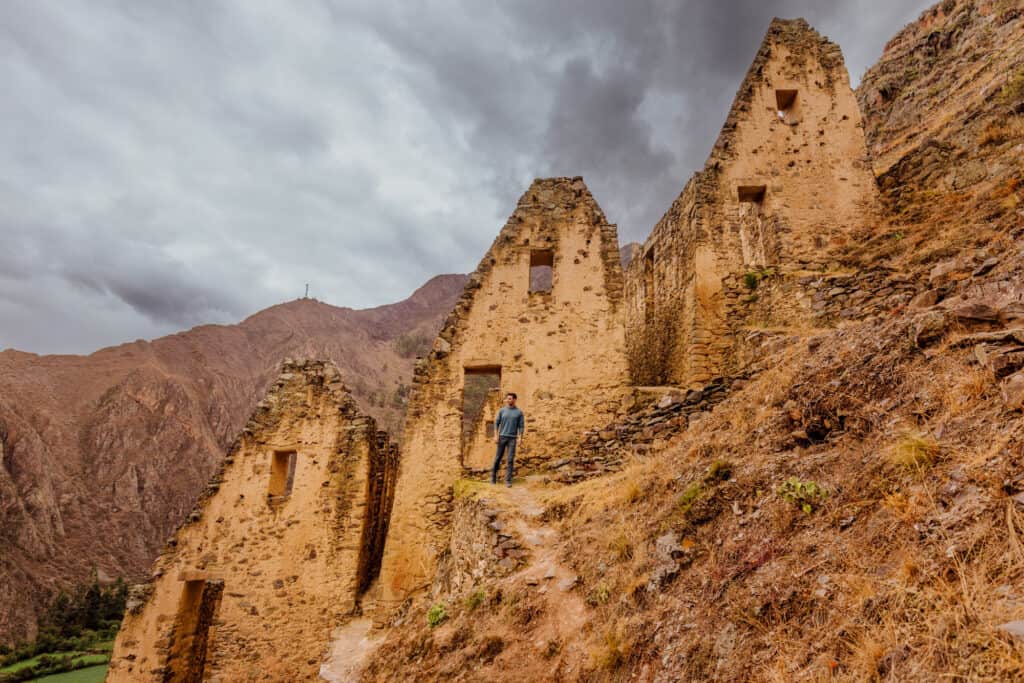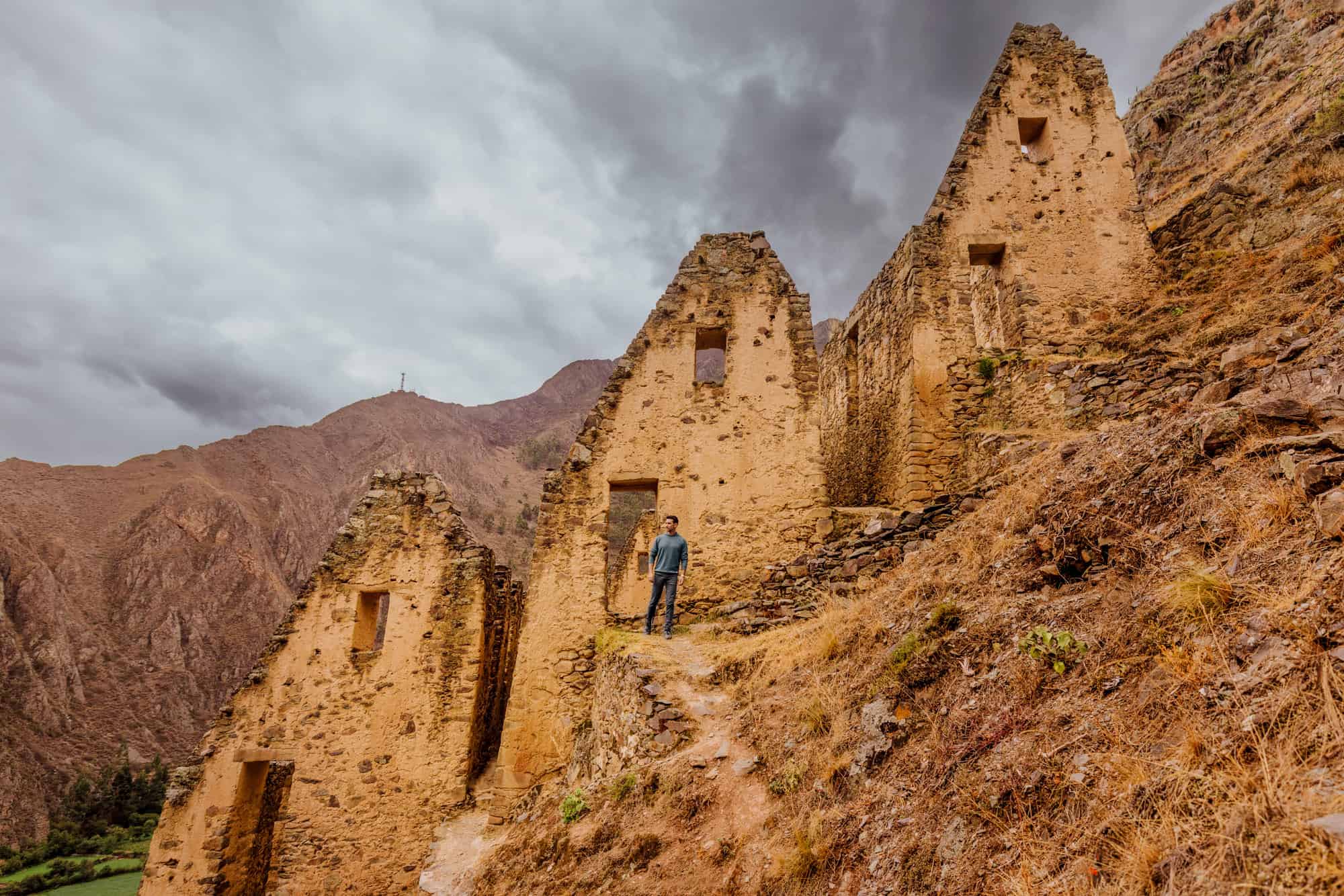Ollantaytambo From Cusco: A Guide to the Ancient Inca Town

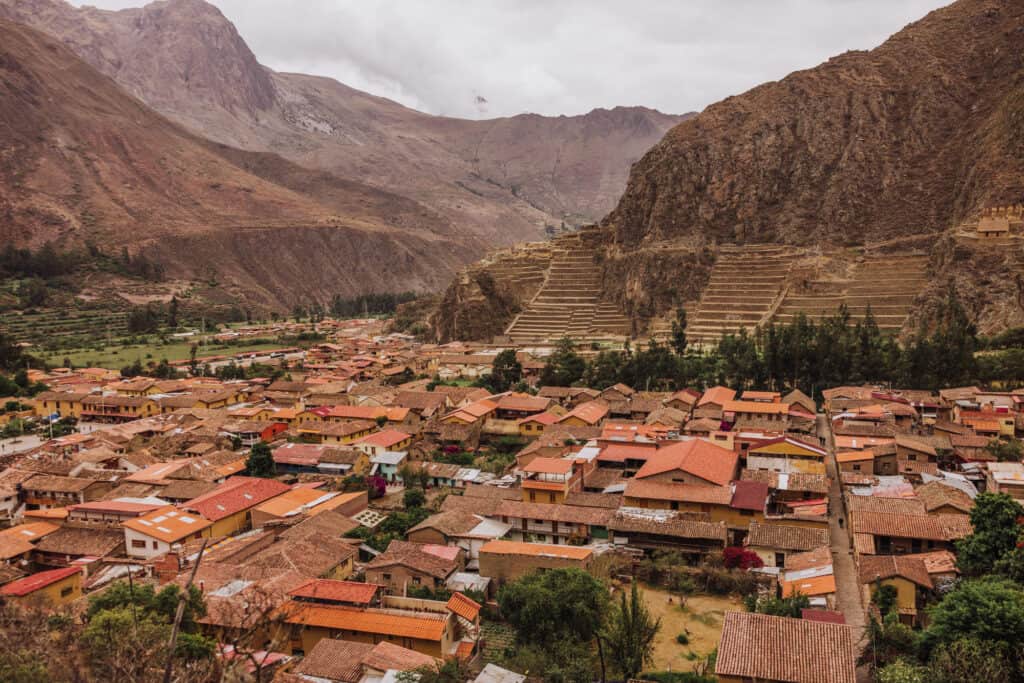
I missed out on visiting Ollantaytambo from Cusco during my first visit to Peru, and won’t make that mistake again!
Ollantaytambo is one of the best living examples of an ancient Inca town. You’ll love wandering the cobblestone streets, exploring the ruins, hiking above town, and eating at one of the many restaurants.
Even better, it’s a convenient stop on your way to (or from) Machu Picchu. While I’d avoid making the drive to Ollantaytambo from Cusco on my own, it’s easy and cost-effective to hire a driver, take the train, or hop on a bus.
I’ll explain all the travel options, plus everything there is to do on a visit to Ollantaytambo down below. If you’re looking for something specific, you can use the table of contents to skip down to that part.
Now, Let’s Get to Your Guide to Ollantaytambo!
Tours: Ollantaytambo From Cusco
As I mentioned above, I’m not a fan of driving in Peru. The roads aren’t well-marked, and while major improvements are being made, some of the paved highways are full of potholes, while the dirt roads have ruts.
So in my opinion, if you just have a day to visit Ollantaytambo, it’s best to hire a driver or take a tour.
These are the best options, with the highest reviews:
➡️ Click to Book: Private Shuttle
- Cusco (your hotel) to Ollantaytambo
➡️ Click to Book: Cusco to Sacred Valley
- Day Trip from Cusco: Ollantaytambo, Moray, Maras, Pisac
➡️ Click to Book: Tour & Ollantaytambo Dropoff
- Cusco hotel pickup, and stops at Moray and Maras before you’re dropped off in Ollantaytambo.
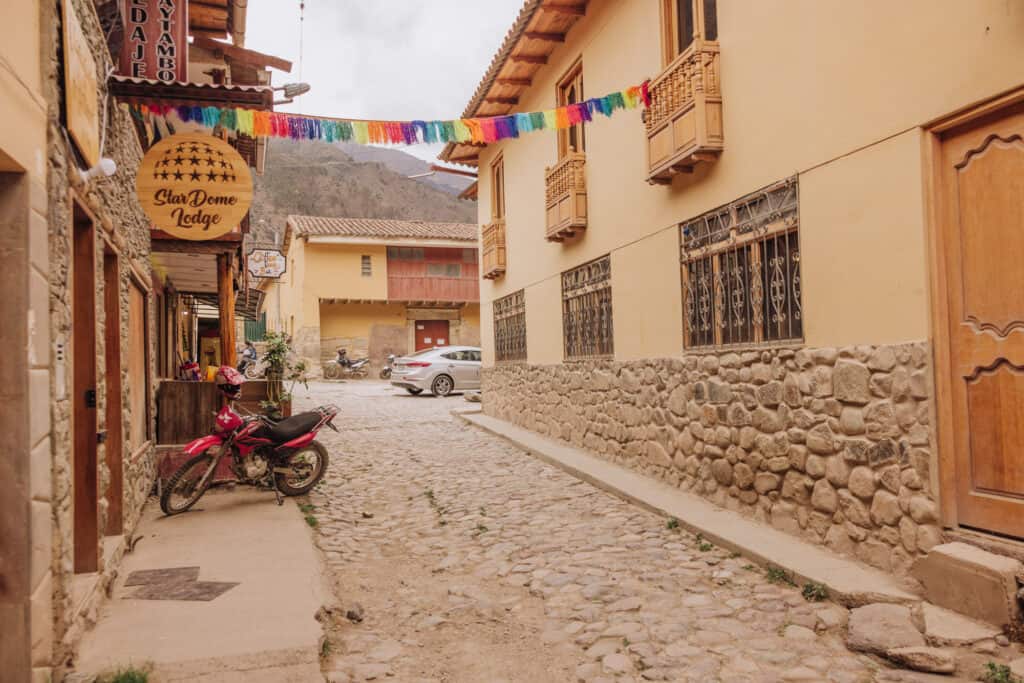
Day Trips to Ollantaytambo From Cusco
If you don’t want to spend the day with a guide, and would rather explore Ollantaytambo at your own pace on your own time, it’s also easy to hire a driver or taxi to take a day trip from Cusco.
Again, I’d avoid renting a car for the drive. The roads are rough and unmarked. Plus, there aren’t many places to park in Ollantaytambo. It’s a very pedestrian-friendly town!
Hire a Driver or Taxi to Ollantaytambo
Generally, a driver will charge about $50 USD to take you to Ollantaytambo from Cusco.
The price will fluctuate sometimes based on demand and the season. It might be more expensive during the peak summer months (June, July, and August).
Depending on traffic and road conditions, the drive to Ollantaytambo will take about 90-minutes to two hours.
You’ll have to ask your driver if they’re available for a round-trip. Chances are: he’ll happily relax in town for the day and wait to drive you back to Cusco at night.
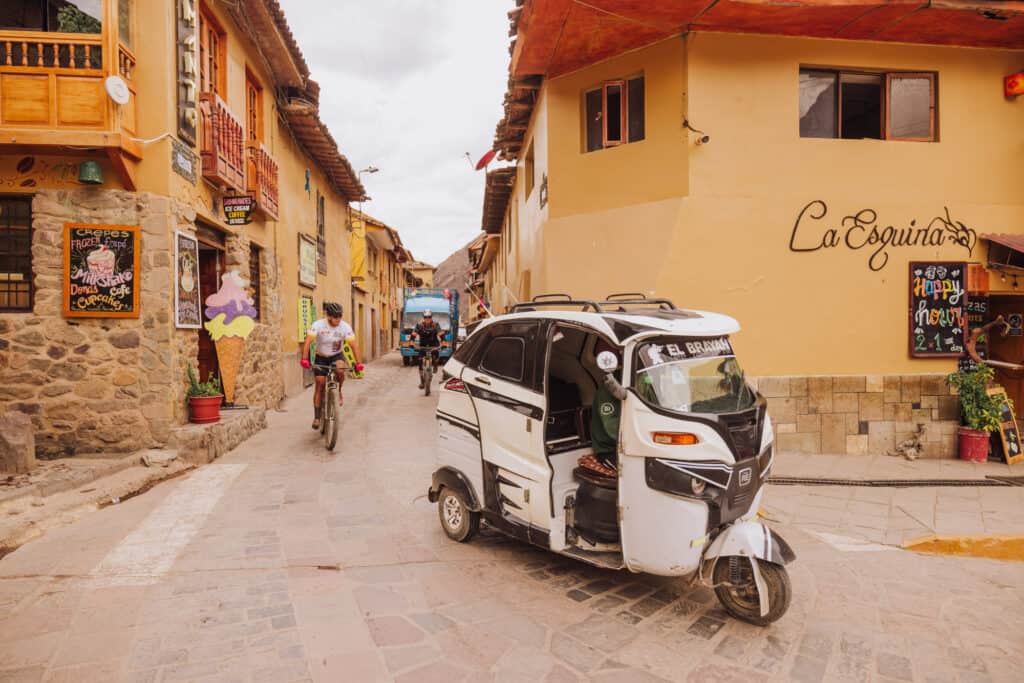
If you’re not sure about your itinerary, you can also easily find a driver anytime in the main square or plaza in Ollantaytambo to take you back to Cusco. Drivers wait there almost around-the-clock, as trains drop passengers off at the station all hours of the day and night.
The Bus From Cusco to Ollantaytambo
Traveling by bus between Cusco and Ollantaytambo is a convenient option for tourists and locals alike.
Bus Companies:
Several bus companies operate the route between Cusco and Ollantaytambo.
I’d choose PeruWays. Their website is easy to use, and the rides are usually around $10 USD.
Travel Time
Similar to the drive time of a taxi, the bus usually takes between 90-minutes and two-hours to get to Ollantaytambo from Cusco.
Bus Departures
Buses usually depart from Cusco’s main bus terminal, Terminal Terrestre. Depending on where your hotel or hostel is, it’s probably easiest to take an Uber or taxi to the bus station.
Bus Prices:
Ticket prices vary based on the bus company, the class of service, the time of day, and whether it’s a direct or indirect route. PeruWays bus fares are usually $10 to $15.
Where to Stay in Ollantaytambo
Ollantaytambo has far fewer hotel options, compared to Cusco or Aguas Calientes (or Machu Picchu Pueblo), but prices are pretty reasonable.
You can use this interactive map to plug in your travel dates to see the options and prices available:
The StarDome Lodge
If you’re staying overnight, I’d recommend booking a room at the StarDome Lodge.
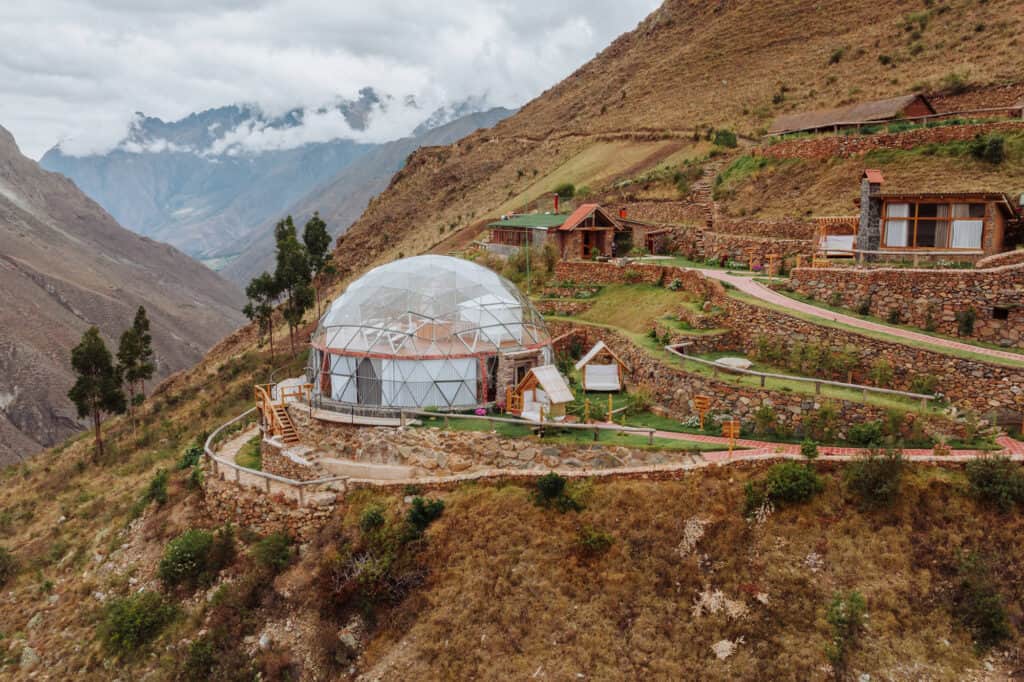
It’s just outside of Ollantaytambo. Their private driver will pick you up and drive you up the mountain to their beautiful retreat.
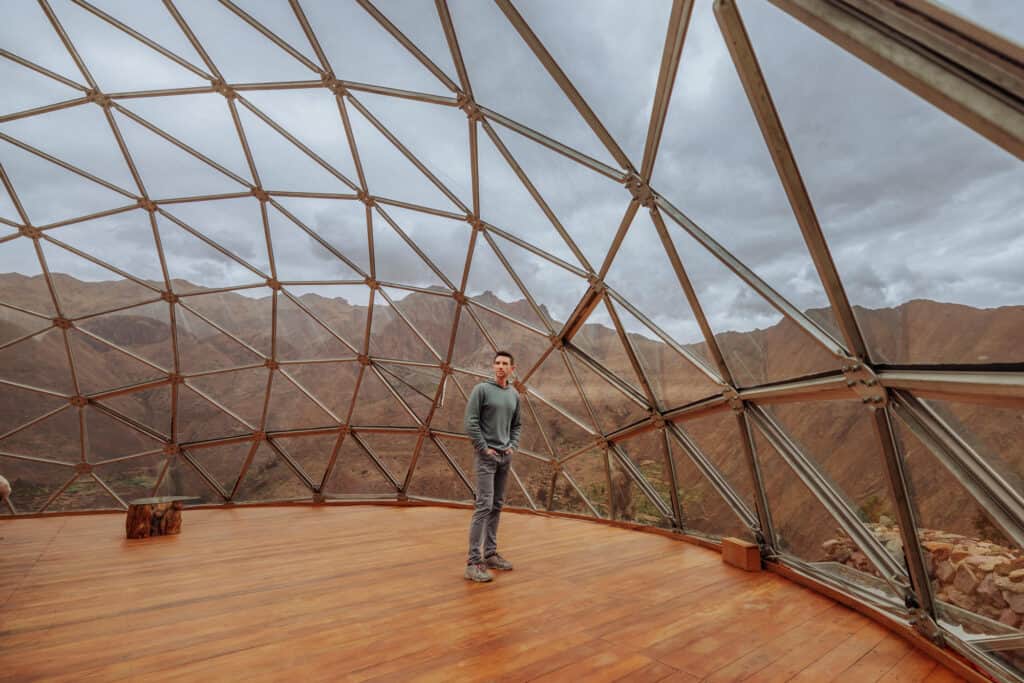
You’ll stay in one of the rooms in the glass dome, or in a separate cabin down a walkway.
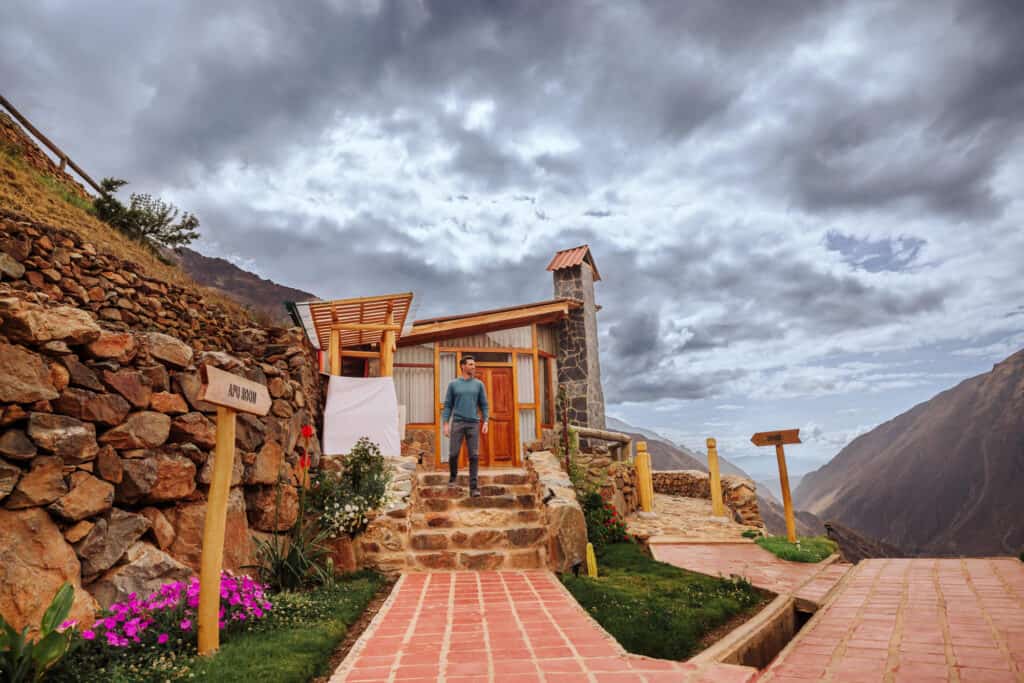
StarDome has a restaurant on site, serving great dinners and breakfasts.
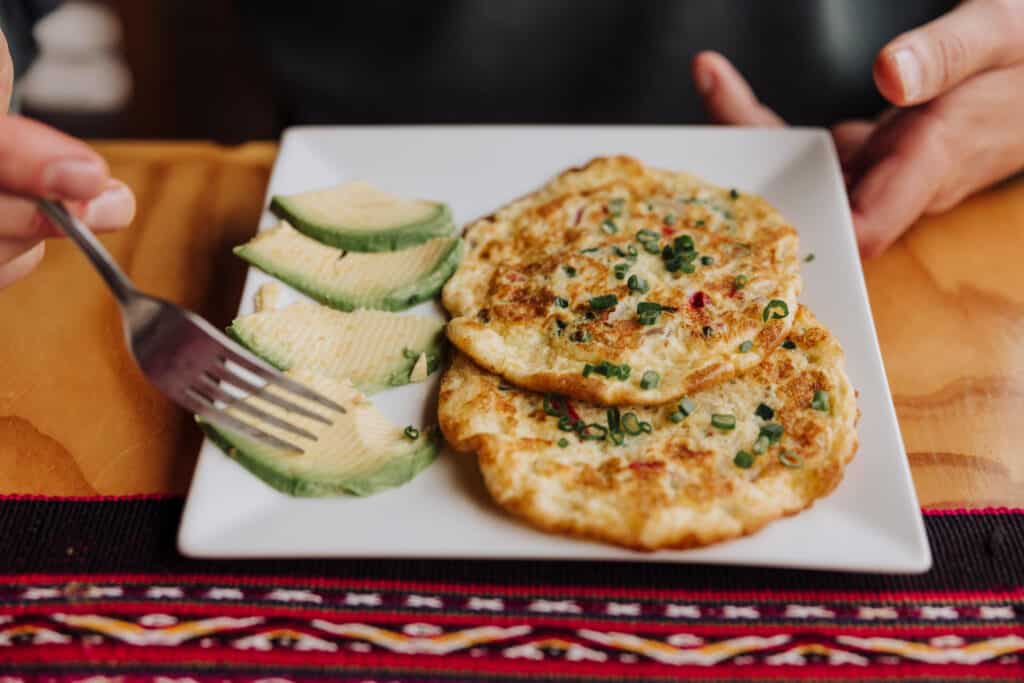
The Ollantaytambo Ruins
There are two sets of Inca ruins in Ollantaytambo:
- The main archeological site, consisting of terraces and temples.
- Pinkuylluna, lesser-known ruins of old granaries on a mountain across the valley.
The main site will cost 70 Soles, or just under $20 USD to enter. The pass, which you can buy right on site, will also grant entry to the Moray ruins nearby.
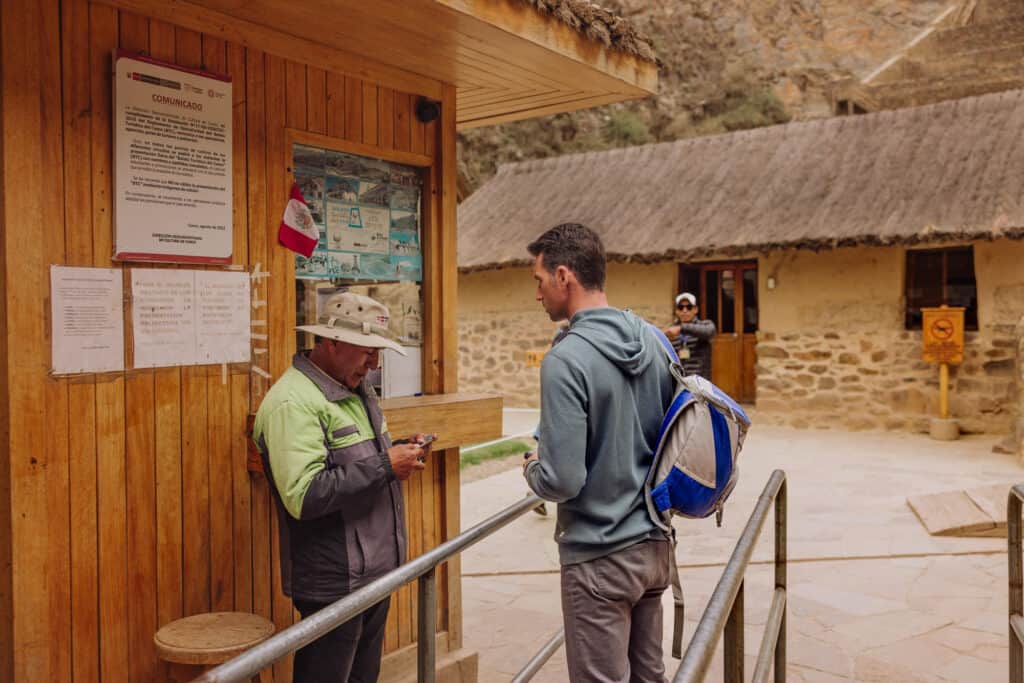
The Main Archeological Site
Ollantaytambo was a strategic military, religious, and agricultural center during the Inca Empire. It functioned as a fortress guarding the entrance to the Sacred Valley.
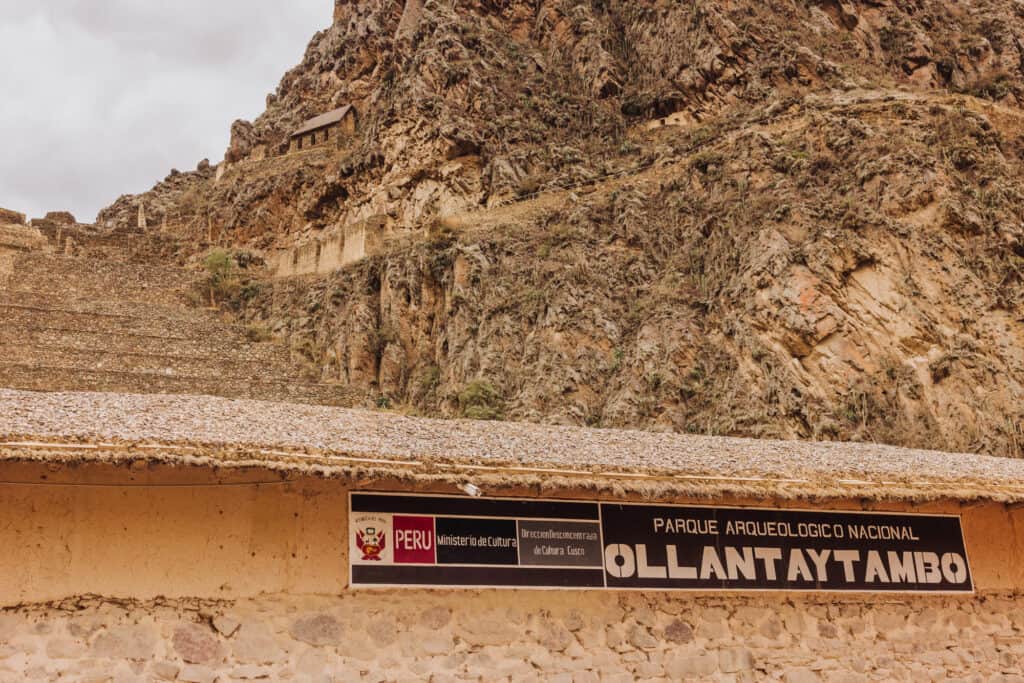
The ruins consist of:
- Farming Terraces: These terraces were not only used for agriculture, but also served to stabilize the hillsides.
- Temple of the Sun: One of the prominent structures at Ollantaytambo, believed to have been a ceremonial site dedicated to the worship of the sun.
- Military Complex: Guardhouses, walls, and defensive positions.
- Water Temple and Fountains: Stone channels and fountains demonstrate the advanced hydraulic engineering skills of the Incas.
- Residential Areas: There are remnants of housing and living quarters for the elite and commoners.
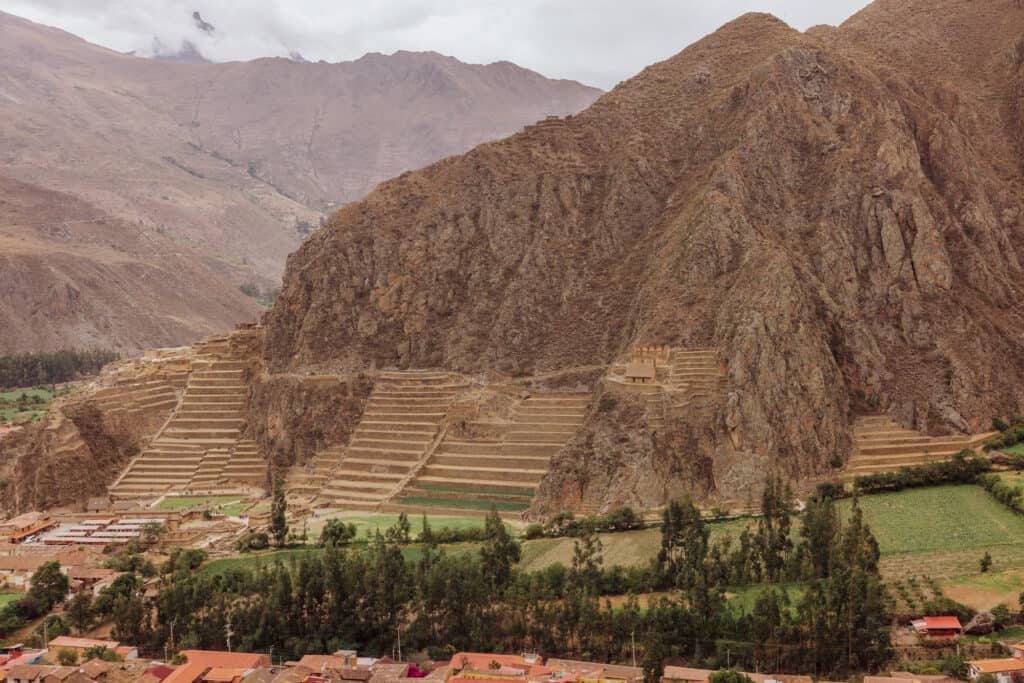
Visitors will be impressed with how the ancient masons were able to fit enormous stones together, some of them weighing tons from quarries miles away.
Guides will be walking around, offering tours and information.
A warning: exploring the Ollantaytambo ruins involves climbing steps, so comfortable shoes are a must! Plus, don’t forget a good SPF.
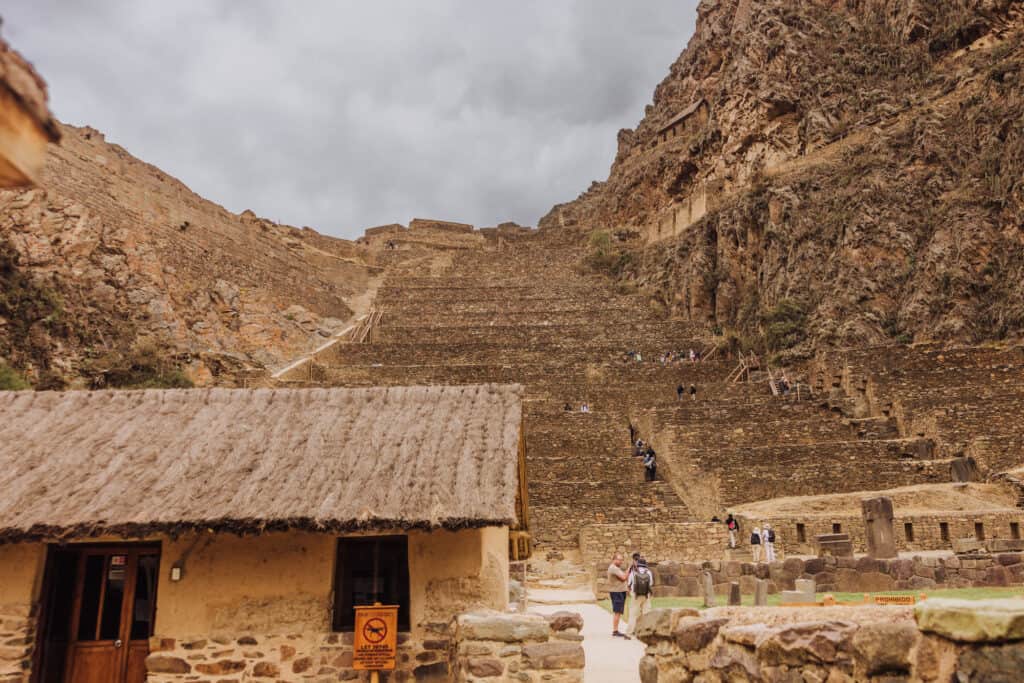
Pinkuylluna
Pinkuylluna is a lesser-known but fascinating set of ruins located on a mountain across from the main archaeological site of Ollantaytambo in Peru.
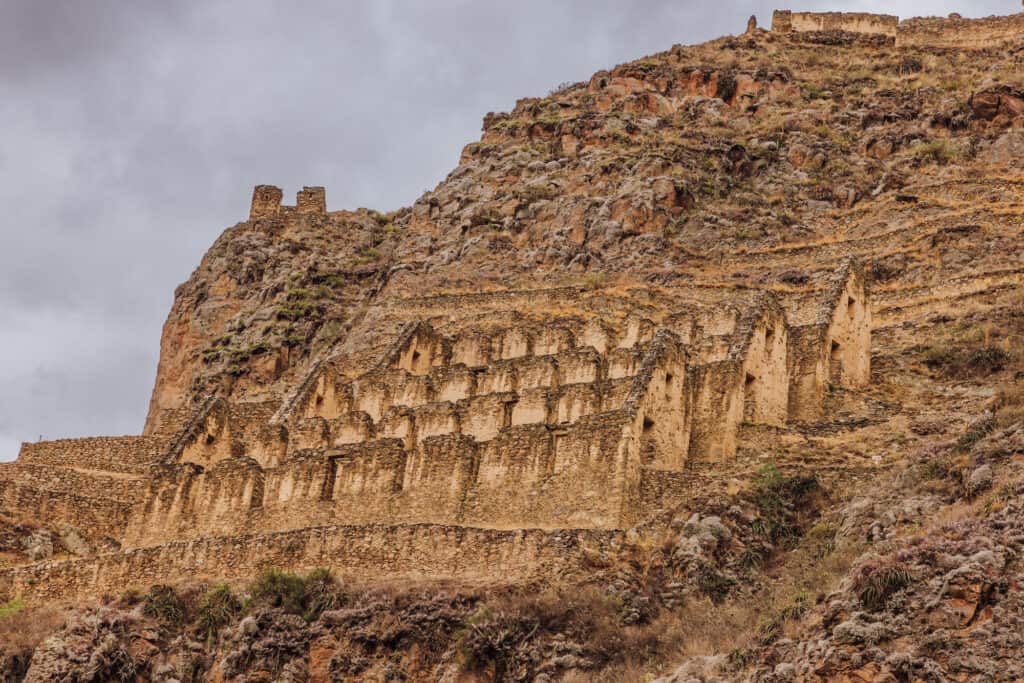
You don’t need a pass or permit. It’s free!
Pinkuylluna consists of ancient Inca storehouses or granaries built into the side of the mountain, which were used to store maize, quinoa, and other food supplies.
Positioned high on the mountain, the location provided natural ventilation and protected the stored goods from rodents and excess moisture.
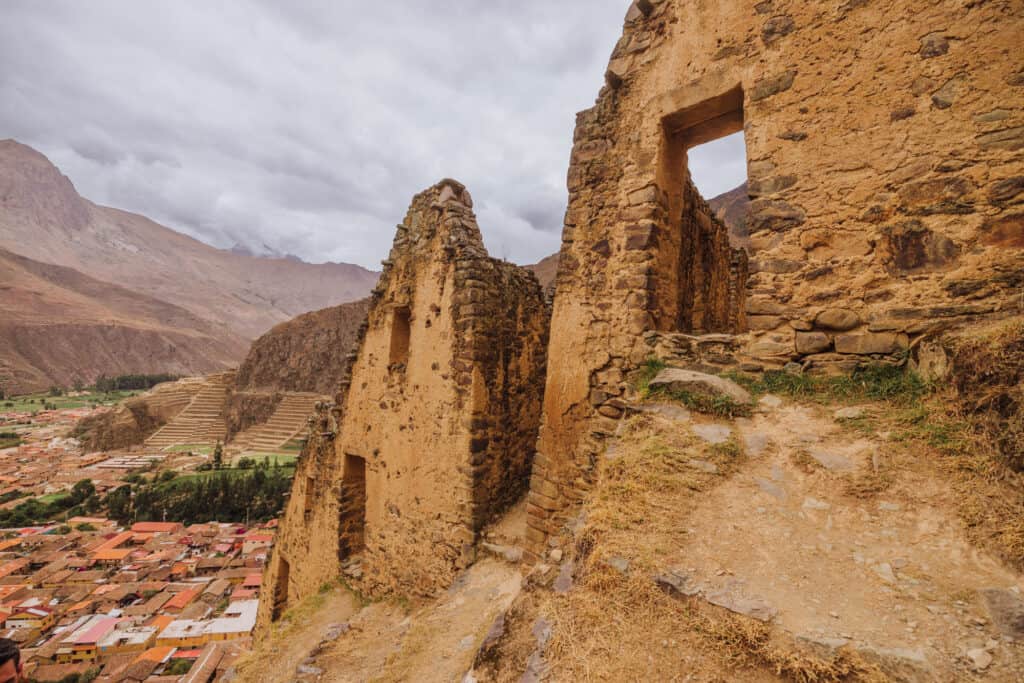
A hike up to Pinkuylluna is challenging and somewhat steep, but the panoramic views of Ollantaytambo, the Sacred Valley, and the surrounding mountains make it worth the trek!
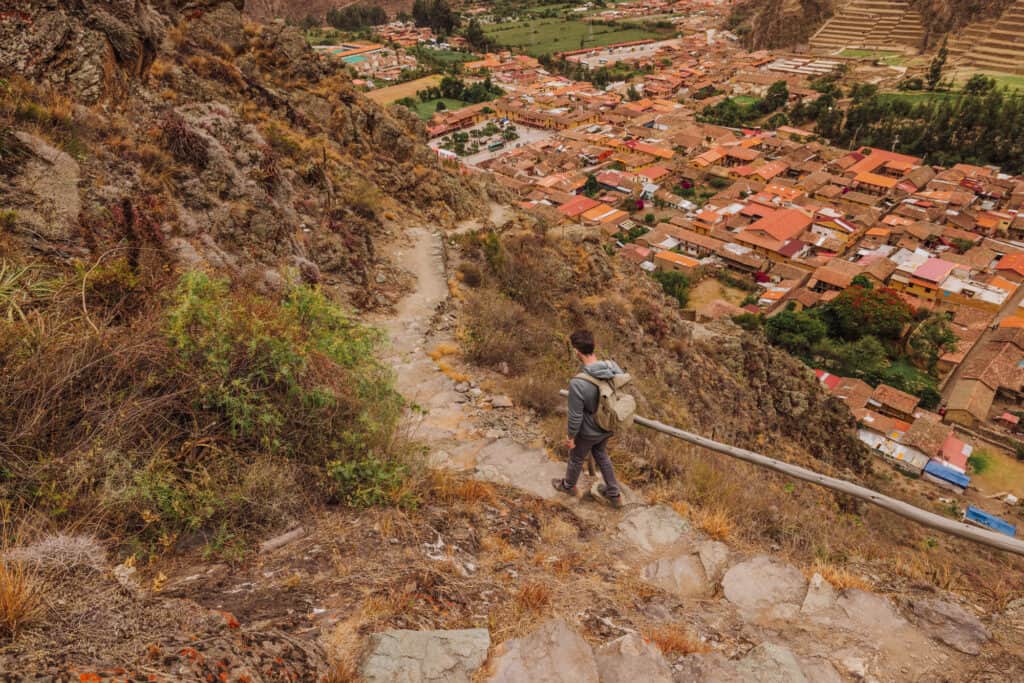
The entrance is on the edge of town, under a sign which essentially tells visitors to “enter at your own risk.”
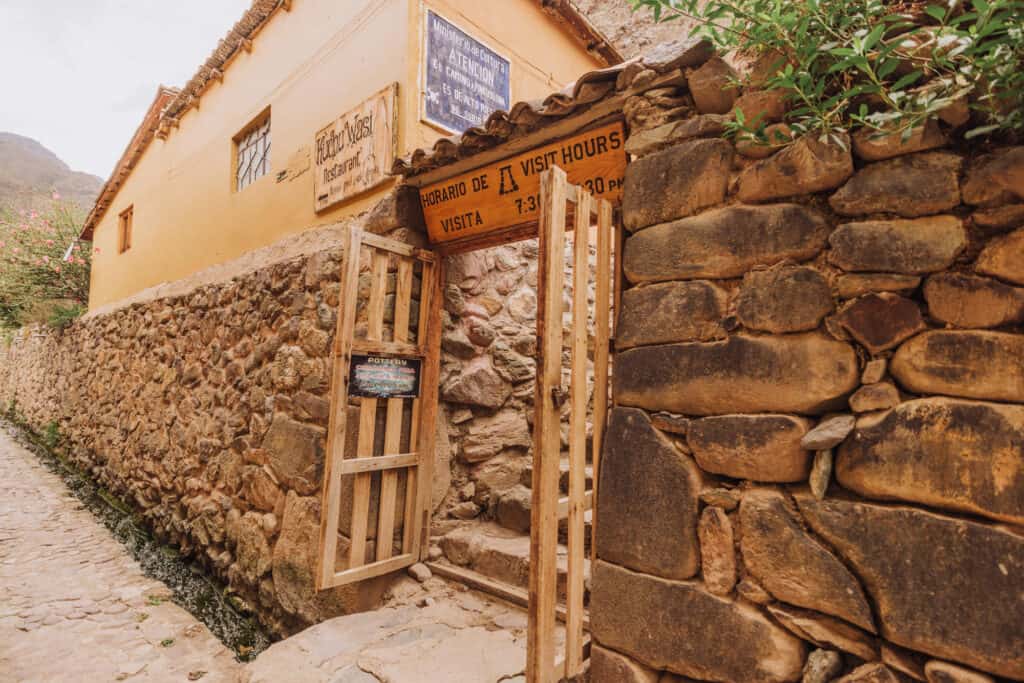
From here, it’s a climb up some stairs, and then on to the steep, rocky trail.
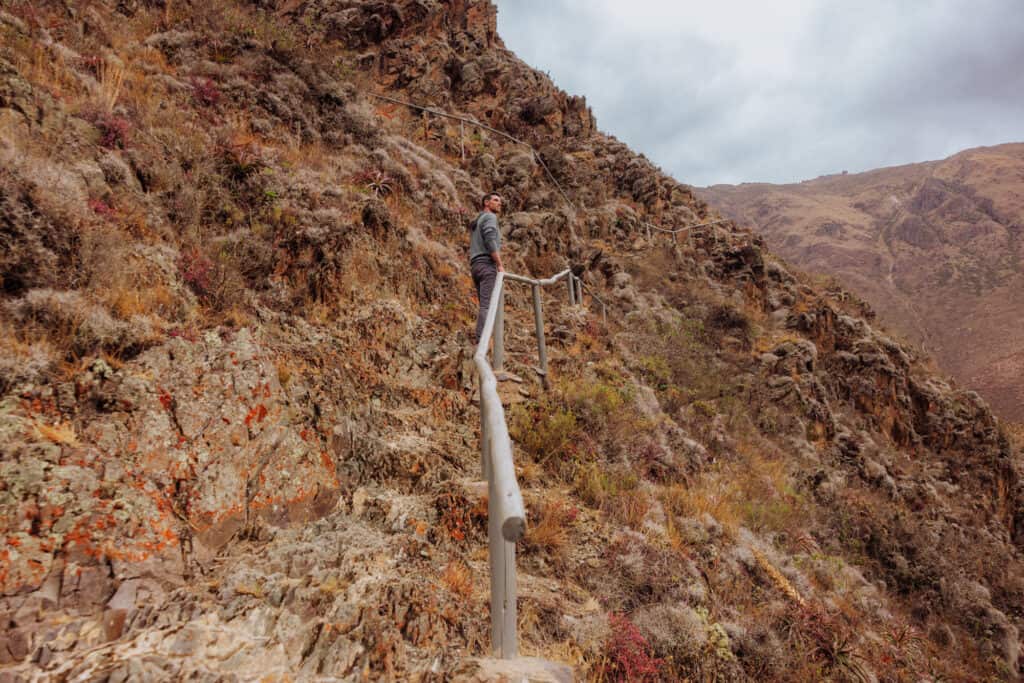
Other Things to Do in Ollantaytambo
The Sacred Valley
The drive alone through the Sacred Valley is a bonus to the trip to Ollantaytambo from Cusco.
We drove down from Moray, and pulled over for a while just to enjoy the view.
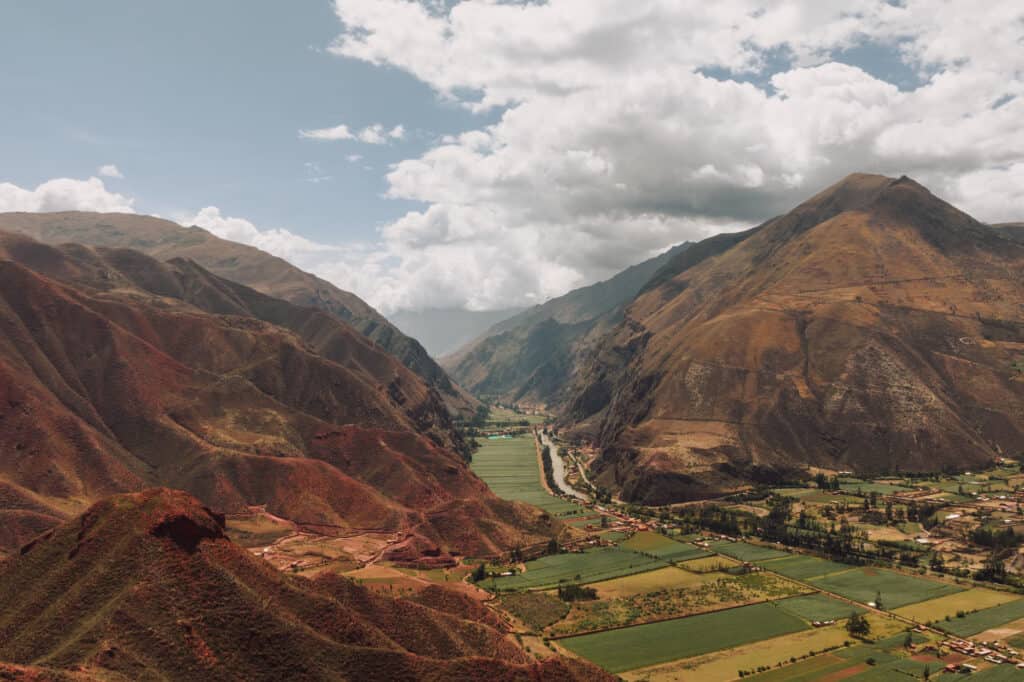
Markets in Ollantaytambo
The town is lined with shops to check out, plus there’s a large open-air market right at the base of the ruins.
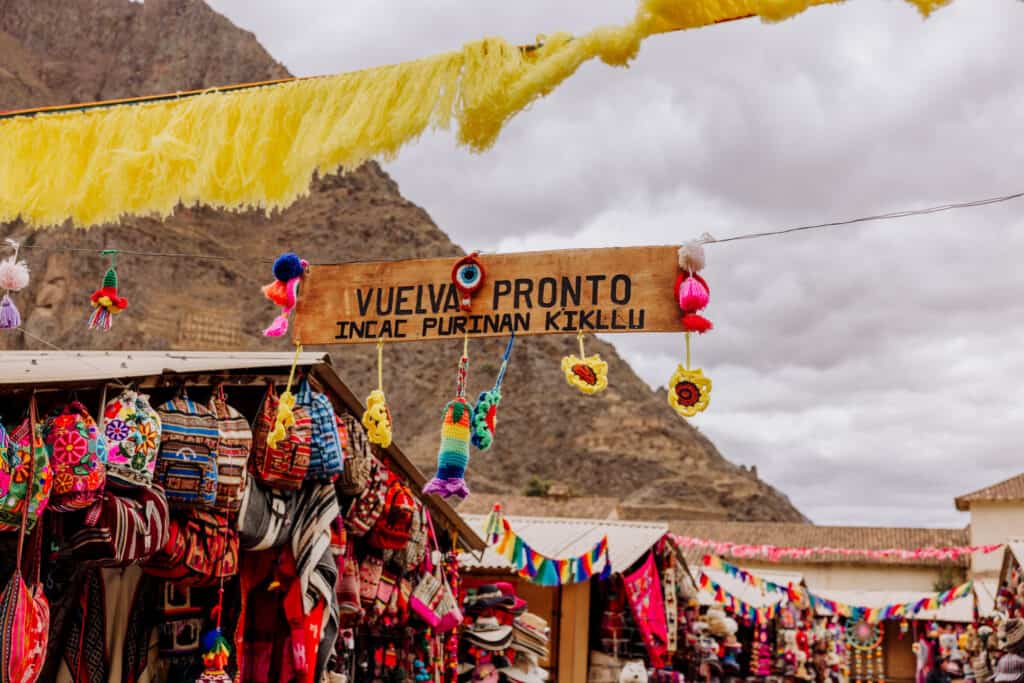
It’s full of gems, art, and other souvenirs.
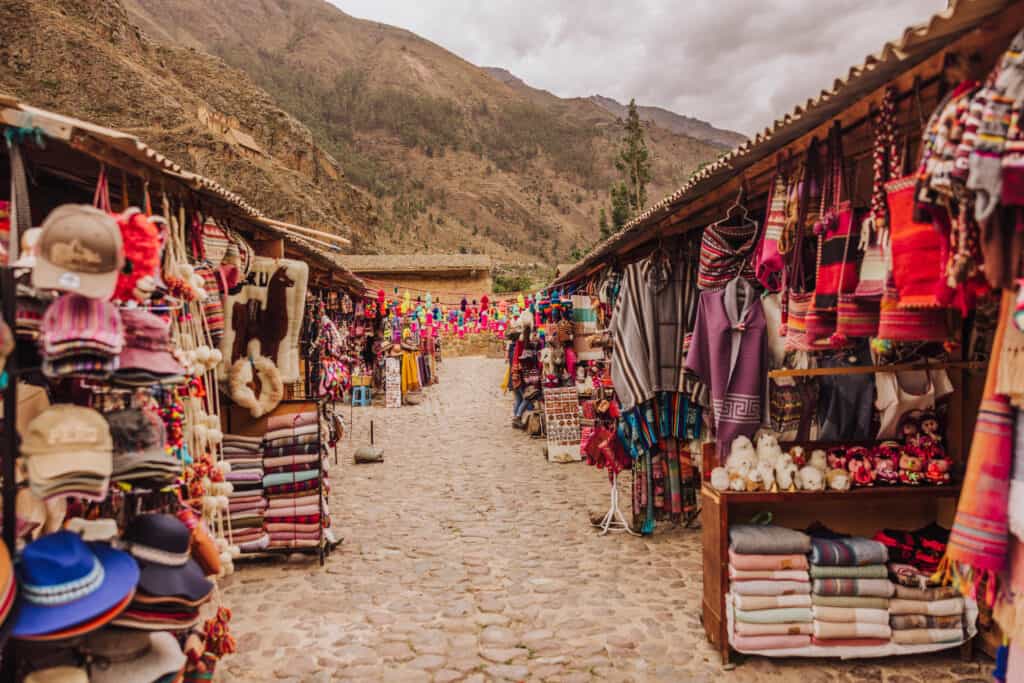

Hike to Inti Punku Sun Gate
Crossing the river, west of Ollantaytambo, you can take a 6-mile hike to the Sun Gate. It’s a challenging hike, with a beautiful view.
Hike to Musqa Pukyo
This is a 2-mile hike north of town, to another set of Inca ruins.
Hike to Pumamarca
Beyond Musqa Pukyo, you’ll arrive at Pumamarca, another set of Inca ruins. The total trek here from Ollantaytambo is about 3-miles.
Maras or Moray
You can hire a driver to take you to the ancient Inca ruins at Moray, or the famous salt mines of Maras, which date back to pre-Inca times.
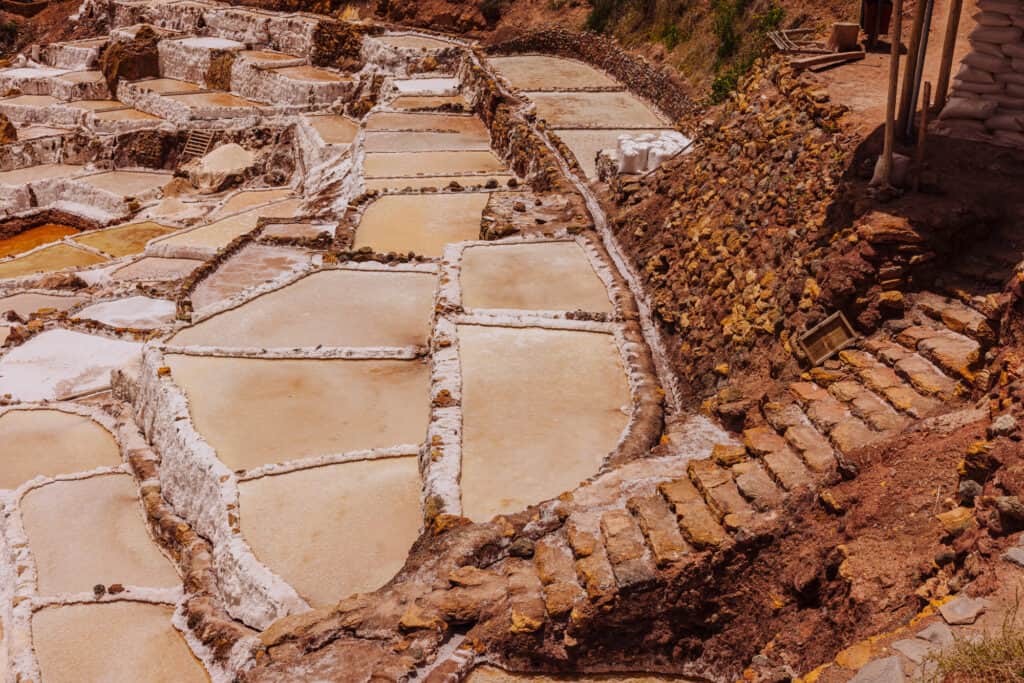
Restaurants in Ollantaytambo
There’s no shortage of restaurants in town. You have your choice of a range of cuisines, both local and international.
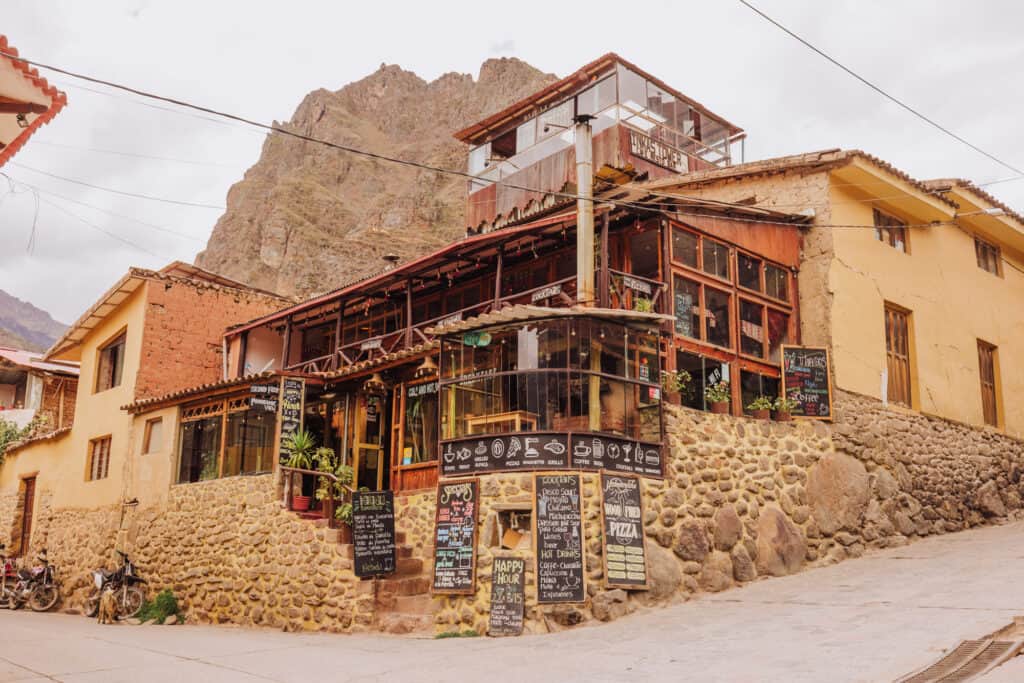
Traditional Peruvian Dishes:
- Ceviche: Fresh fish or seafood marinated in lime juice, onions, and spices.
- Lomo Saltado: Stir-fried beef with onions, tomatoes, and peppers, often served with rice and fries.
- Aji de Gallina: Shredded chicken in a creamy yellow chili sauce, served with potatoes and rice.
- Quinoa Dishes: Quinoa-based salads, soups, or main courses (always my go-to choice!)
- Alpaca or Guinea Pig: Traditional meats often featured in stews or grilled.
- Empanadas: Pastries filled with meats, cheese, or vegetables, served as snacks or appetizers.
International Options:
- Pizzas and Pastas: Many restaurants offer Italian cuisine, including pizzas and pasta dishes.
- Burgers and Sandwiches: Some eateries may serve Western-style sandwiches and hamburgers.
Many of the restaurants in Ollantaytambo have outdoor dining options, along the charming cobblestone streets.
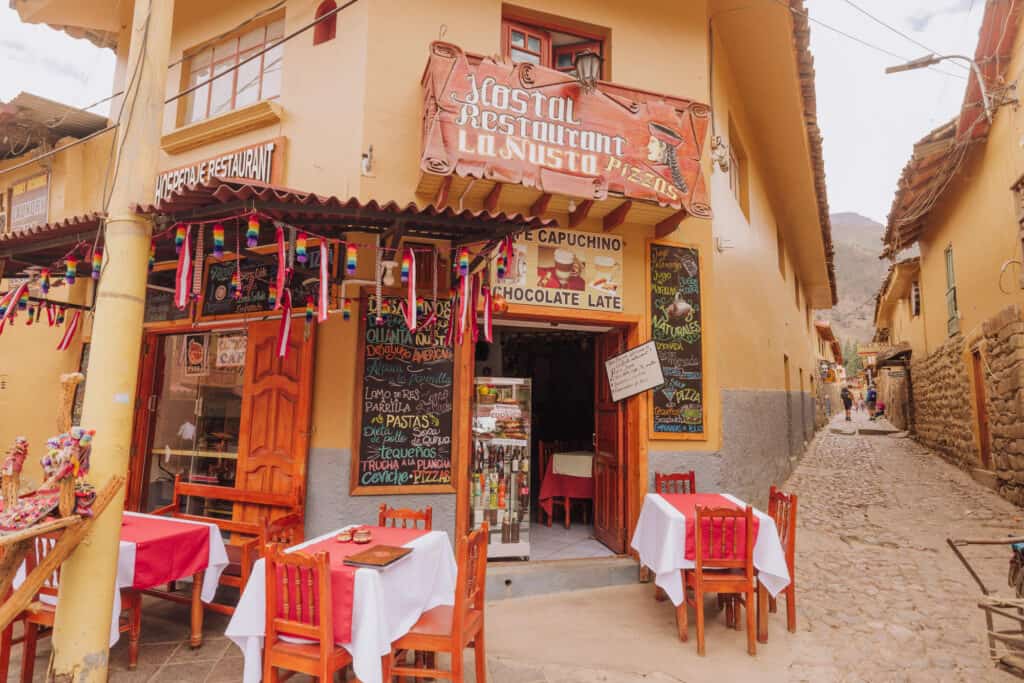
And of course, it wouldn’t be a visit to Peru without a sample of the national cocktail: the Pisco Sour. It’s made with pisco (grape brandy), lime juice, syrup, and egg whites.
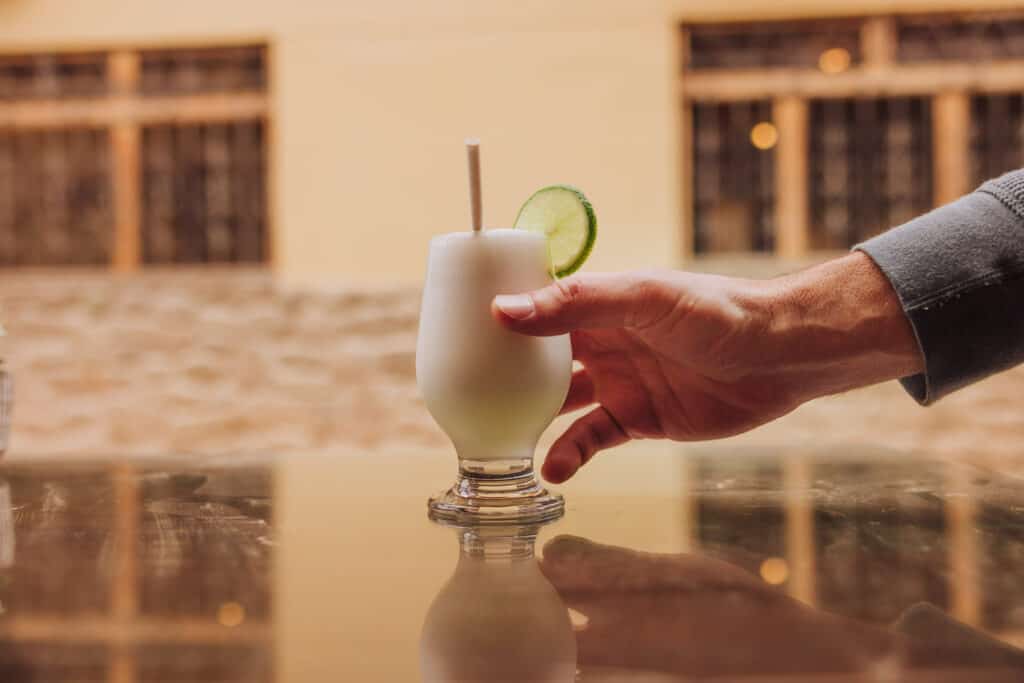
The Ollantaytambo Train Station
Ollantaytambo’s train station is on the edge of town, along the river.
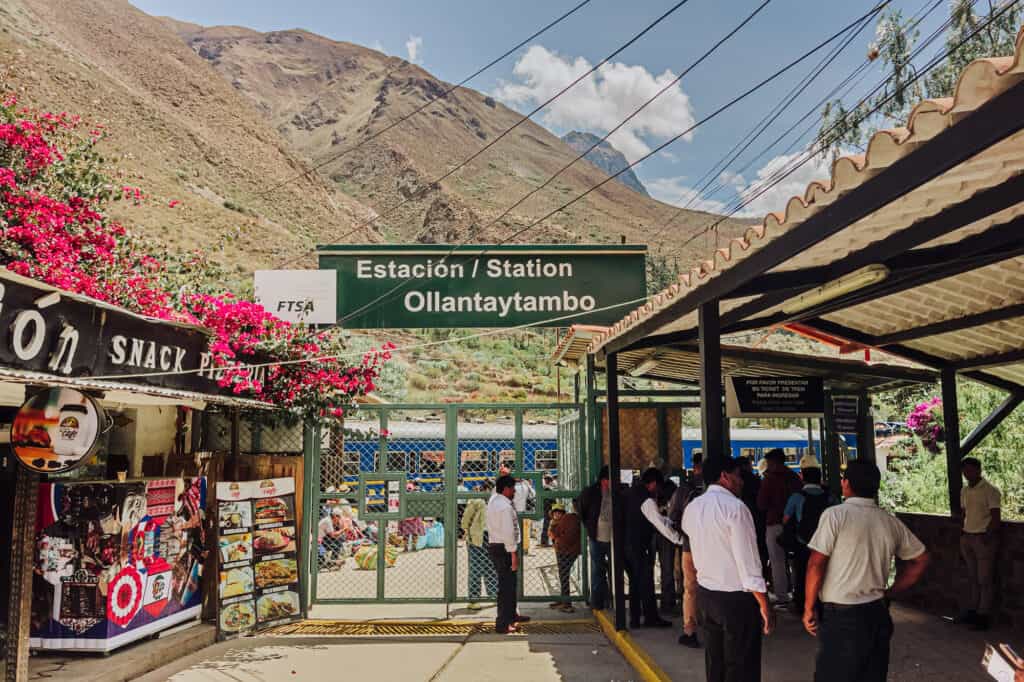
It’s a bustling operation, with trains arriving or departing from Cusco or Machu Picchu Pueblo (Aguas Calientes) from the early morning hours to late at night.
It’s hectic and chaotic at times, but they’ll have staff on hand to help direct you to the right platform.
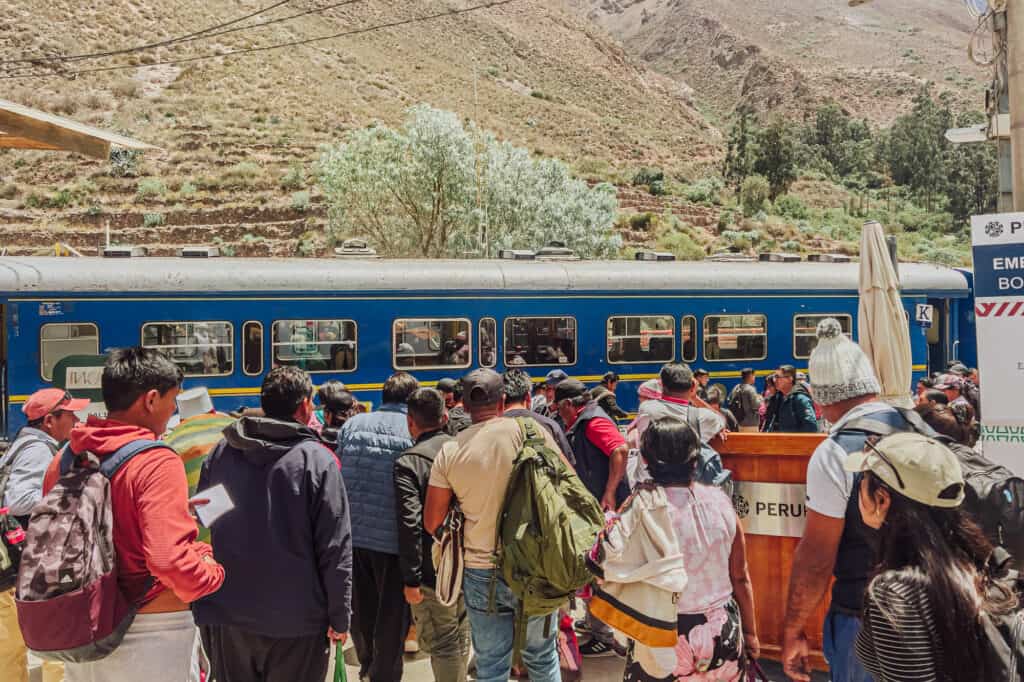
Cost of the Train From Cusco
You can check the Inca Rail or PeruRail websites for timetables and prices. They’ll vary widely, depending on times, level of service, and other factors.
I usually opt for the Vistadome option on PeruRail, which is usually around $100 USD for a ticket. I love the glass ceilings!
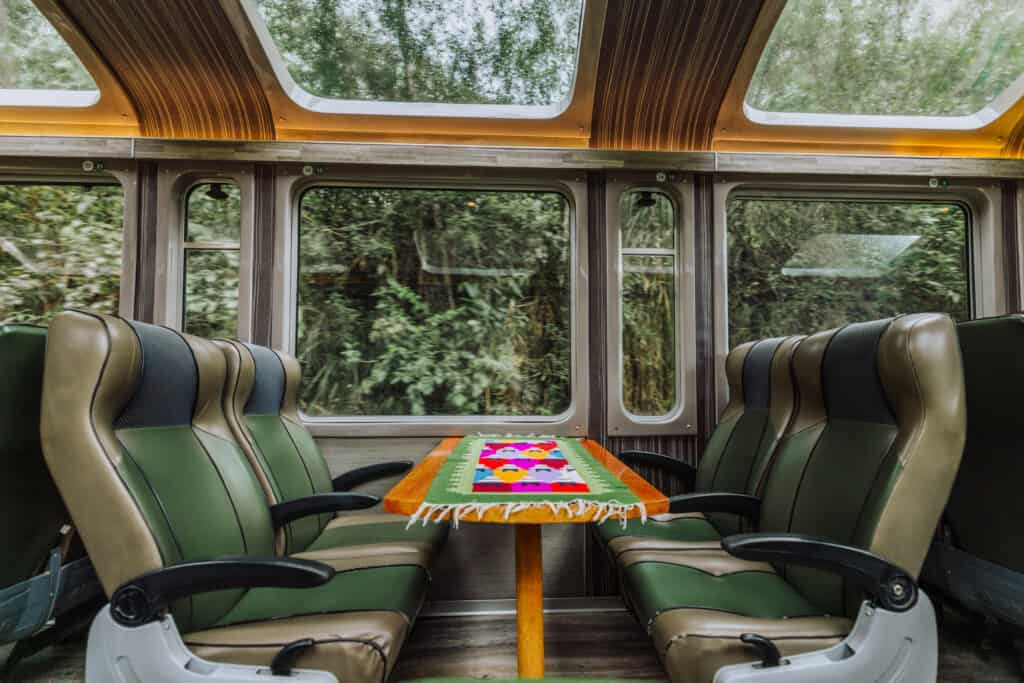
Personally, I prefer hiring a driver to get to Ollantaytambo from Cusco, and then taking the train from Ollantaytambo to Machu Picchu Pueblo.
The Train to Machu Picchu
The ride takes about 90 minutes, and the train follows the river from Ollantaytambo to Machu Picchu Pueblo.
You’ll pass other archeological sites, and the start of the Inca Trail along the way.
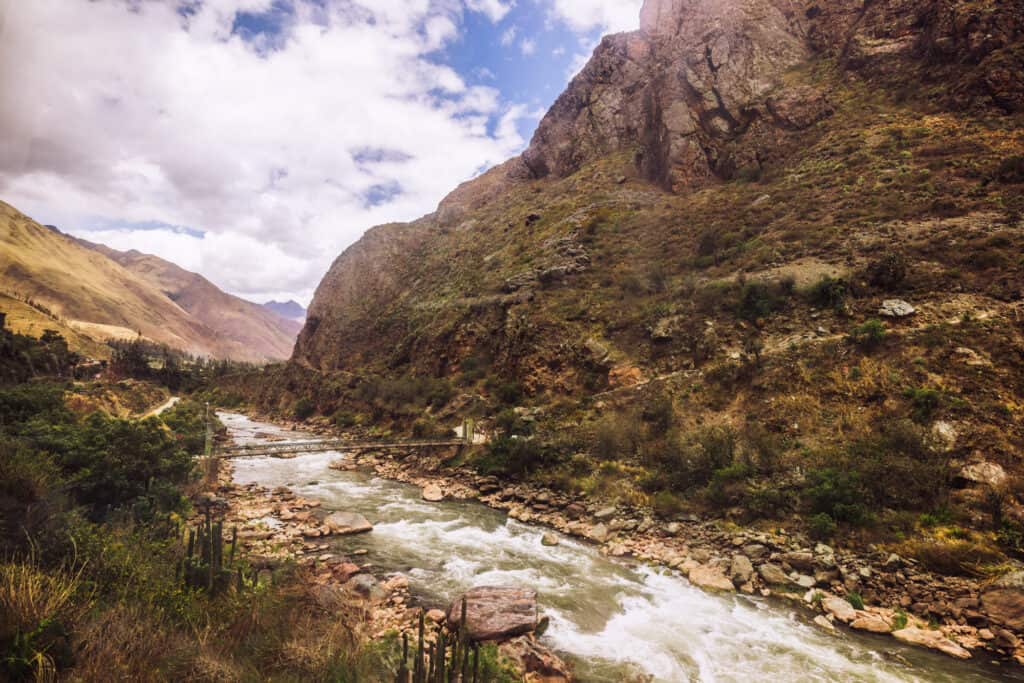
There’s no WiFi, and you’ll lose cell signal along the way.
Depending on the ticket you buy, they’ll serve drinks and snacks on the ride.

Ollantaytambo to Machu Picchu Pueblo
There are no roads to Machu Picchu Pueblo (or Aguas Calientes), the tourist town considered the gateway to the ancient Inca site.
So, you can’t hire a driver, take a taxi, or a bus to Machu Picchu. Unless you want to hike in, you’ll have to take the train.
I mentioned the options above. PeruRail and Inca Rail operate several trains a day between Ollantaytambo and Machu Picchu Pueblo. The ride is 90-minutes, and will take you through along the river through a gorgeous valley.
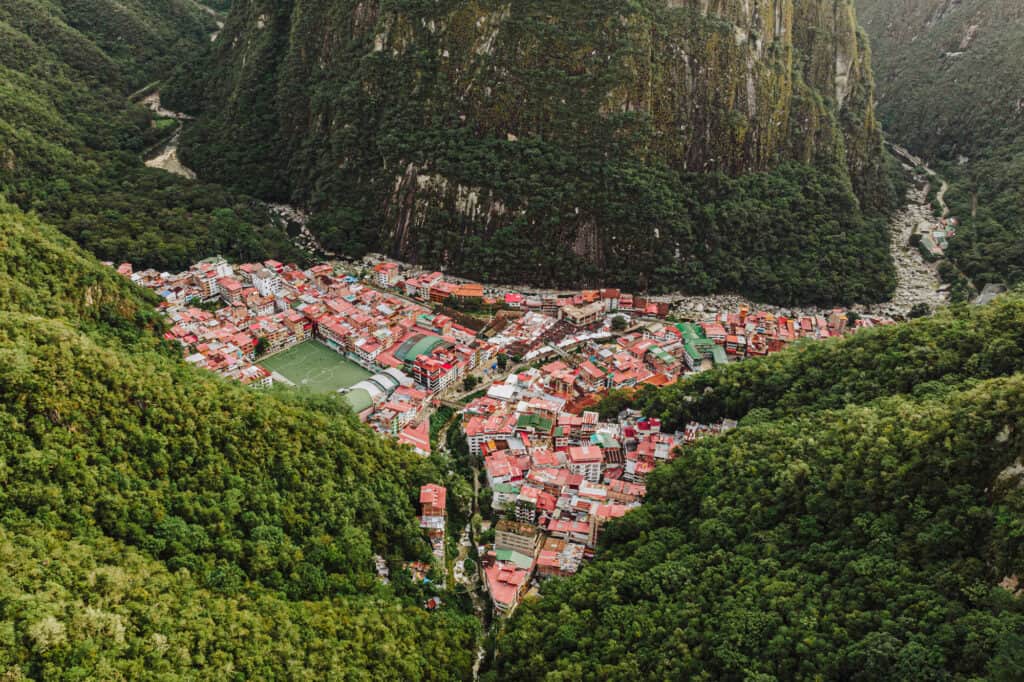
The Weather in Ollantaytambo
Ollantaytambo is mild year-round, but rainfall varies by the season.
Here’s a general guide of what you can expect:
Dry Season (May to October):
- Temperature: Daytime temperatures range from around 60°F to 70°F, occasionally reaching into the mid-70s during the day. Nighttime temperatures can drop to around 35°F to 45°F.
- Rainfall: This period experiences minimal rainfall, with very little to no precipitation. Rainfall may total less than 1 inch per month during the dry season.
Wet Season (November to April):
- Temperature: Daytime temperatures range between 60°F and 70°F on average. Nights can be slightly cooler, ranging from 40°F to 50°F.
- Rainfall: Precipitation levels increase, but vary month-to-month. Rainfall can range from about 1 inch to over 5 inches per month, with December through March typically being the wettest months in Ollantaytambo.
No matter where you’re going in Peru, and no matter the time of year, it’s best to bring layers to add and shed through your day!
Of course, you can always pick up a souvenir layer to wear along the way…

Ollantaytambo’s Elevation
Ollantaytambo’s elevation is approximately 9,200 feet (2,800 meters) above sea level.
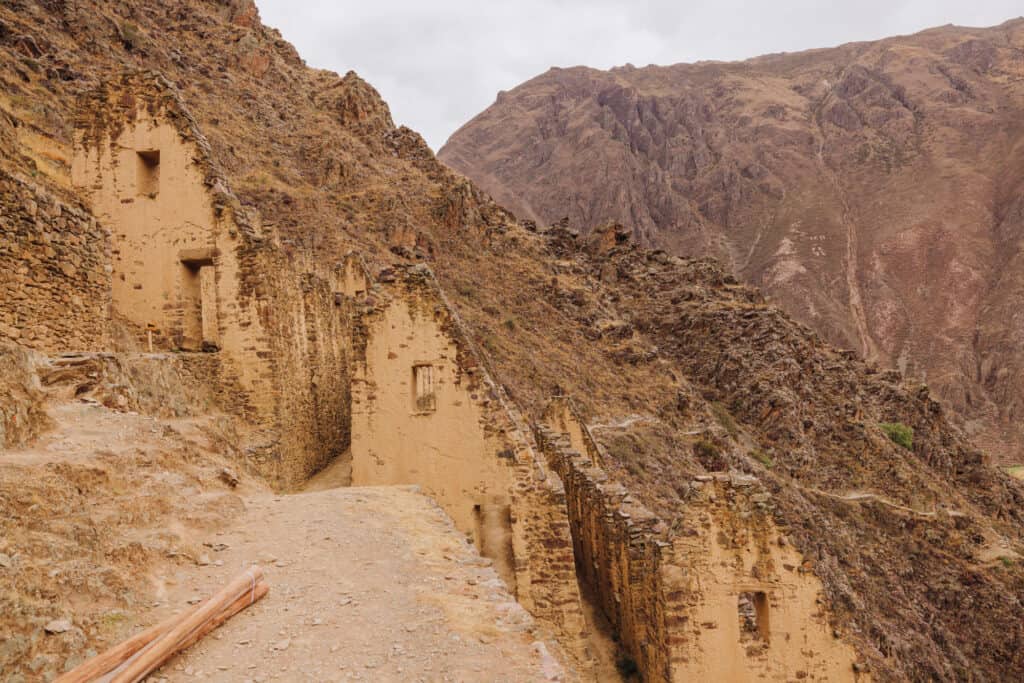
Here’s how it compares to other popular tourist sites in the Cusco region:
- Cusco City: Around 11,152 feet (3,399 meters) above sea level.
- Pisac: About 9,750 feet (2,972 meters) above sea level.
- Maras Salt Ponds (Salineras de Maras): Around 11,090 feet (3,380 meters) above sea level.
- Machu Picchu: Approximately 7,972 feet (2,430 meters) above sea level.
- Pallay Punchu: Approximately 13,000 feet.
- Humantay Lake: Approximately 11,000 feet.
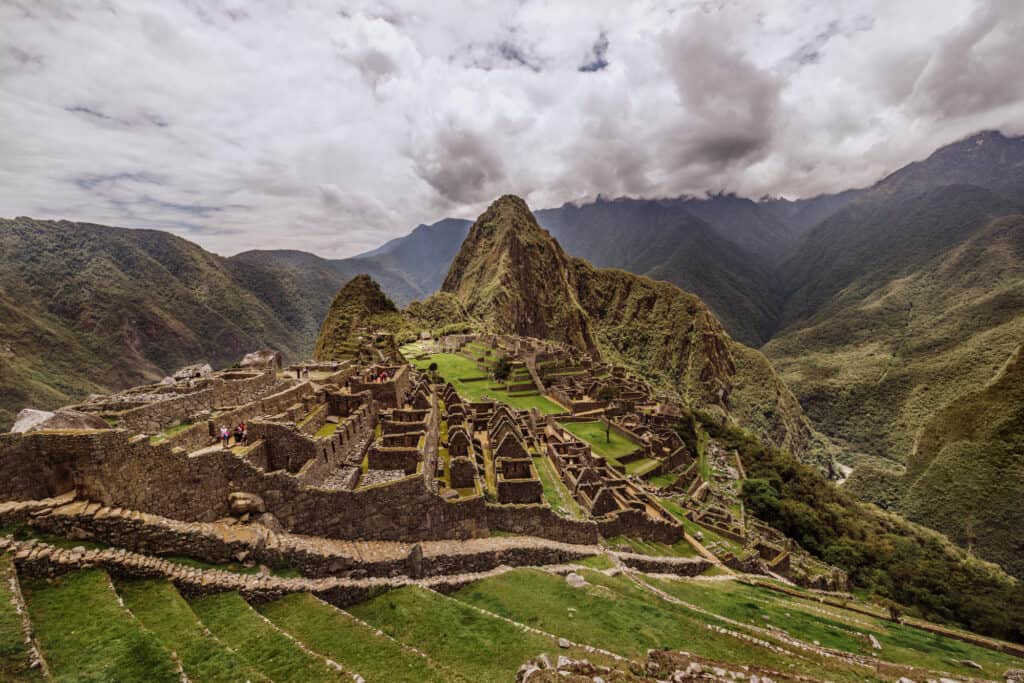
Interesting Facts and History of Ollantaytambo
Interesting Facts about Ollantaytambo:
- Inca Construction: Ollantaytambo showcases some of the finest surviving examples of Inca stonework, including massive terraces and walls made of precisely cut stones without mortar.
- Strategic Military Site: It served as a key military stronghold during the Inca Empire, playing a crucial role in defending the Sacred Valley against the Spanish conquistadors.
- Legend of Ollantay: The town derives its name from the Inca rebellion leader Ollantay, whose story is preserved in oral tradition and has become part of Andean folklore.
- Sun Temple and Astronomical Alignment: The Temple of the Sun in Ollantaytambo is believed to have been constructed with precise astronomical alignments, possibly serving as an observatory for the Incas.
- Water Engineering Ingenuity: The intricate water channels and fountains found at the site showcase the Inca’s advanced hydraulic engineering skills, with carefully designed systems for water distribution and irrigation.
- Gateway to the Amazon: Ollantaytambo was a crucial point along the Inca road system that connected the Andes to the Amazon rainforest, facilitating trade and communication between diverse regions of the empire.
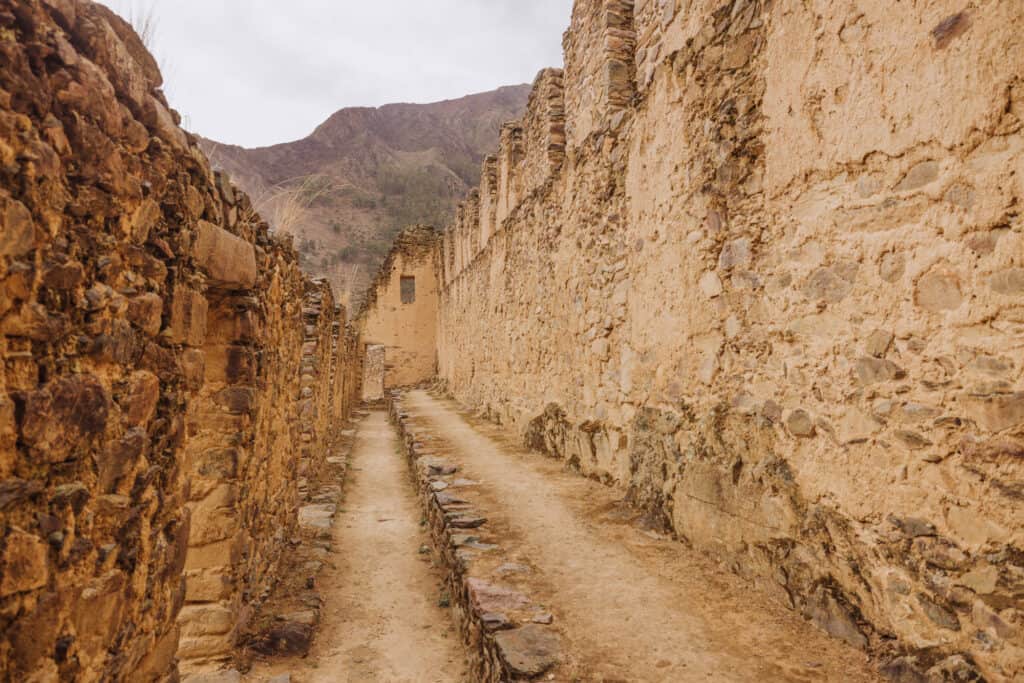
Brief History of Ollantaytambo:
Here’s a brief, incomplete breakdown of the history of Ollantaytambo:
- Inca Era: Constructed during the height of the Inca Empire, Ollantaytambo was primarily a religious, military, and agricultural center. Its strategic location made it a key point in the Inca road network.
- Battle of Ollantaytambo (1537): In 1537, it became the site of a significant battle between the Inca forces led by Manco Inca Yupanqui and the Spanish conquistadors led by Hernando Pizarro. Although the Inca initially had success, they ultimately retreated to Vilcabamba.
- Colonial Era: After the Spanish conquest, Ollantaytambo became part of the colonial estates granted to Hernando Pizarro. The Spanish built upon Inca foundations, using the town for administrative purposes.
- Preservation of Inca Heritage: Due to its relative isolation, Ollantaytambo retained much of its original Inca infrastructure and architecture, making it a significant archaeological site today.
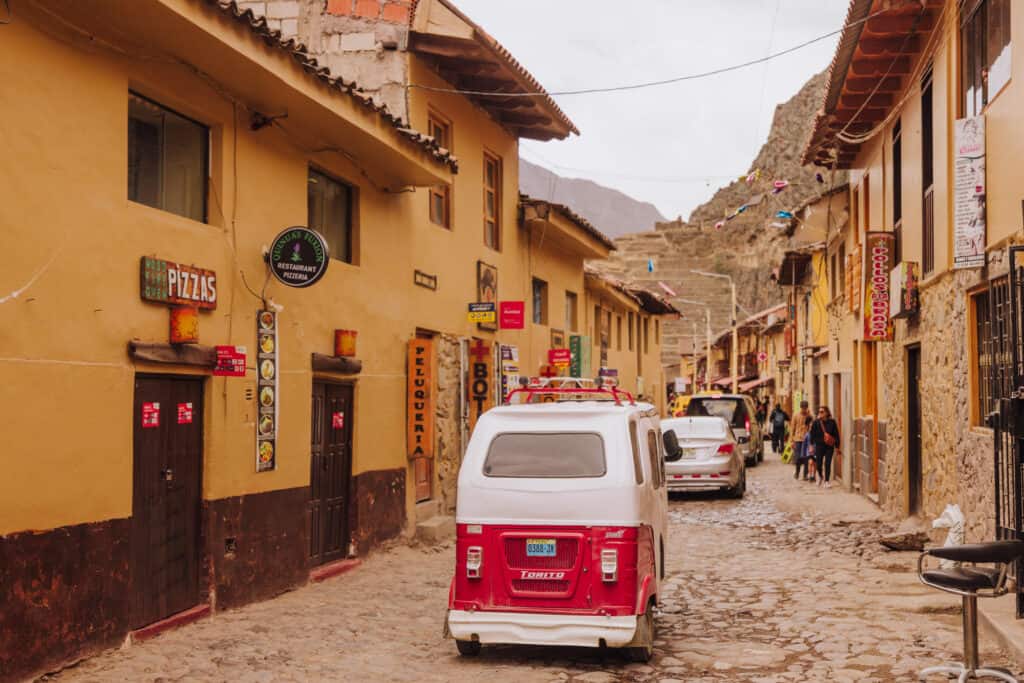
FAQs on a Day Trip to Ollantaytambo
Let’s go over a few frequently-asked-questionsi about a trip to Ollantaytambo from Cusco. Many of these were also answered above.
Where is Ollantaytambo?
Ollantaytambo is a town located in a part of Peru, known as the Sacred Valley of the Incas. It’s about 37 miles northwest of the city of Cusco.
Should I drive to Ollantaytambo from Cusco?
I’d advise against driving yourself around in Peru, unless you have plenty of time to get lost, have no strict itinerary, and can speak Spanish fluently.
- The roads and highways aren’t well-marked.
- Many popular sites require drives on rough, dirt roads.
- There aren’t many parking options in a place like Ollantaytambo.
- Hiring a local driver is just as cost-effective.
How far is Ollantaytambo from Cusco?
The drive from the central part of Cusco to Ollantaytambo is 37 miles.
How long does it take to go from Cusco to Ollantaytambo?
The drive from the city of Cusco to Ollantaytambo will take around 90 minutes, depending on traffic and construction.
Can you Uber from Cusco to Ollantaytambo?
Uber is a great option in Peru. You’ll usually be able to find a driver who will take you from Cusco to Ollantaytambo. It’ll likely be easier to book a ride in advance, just to be sure.
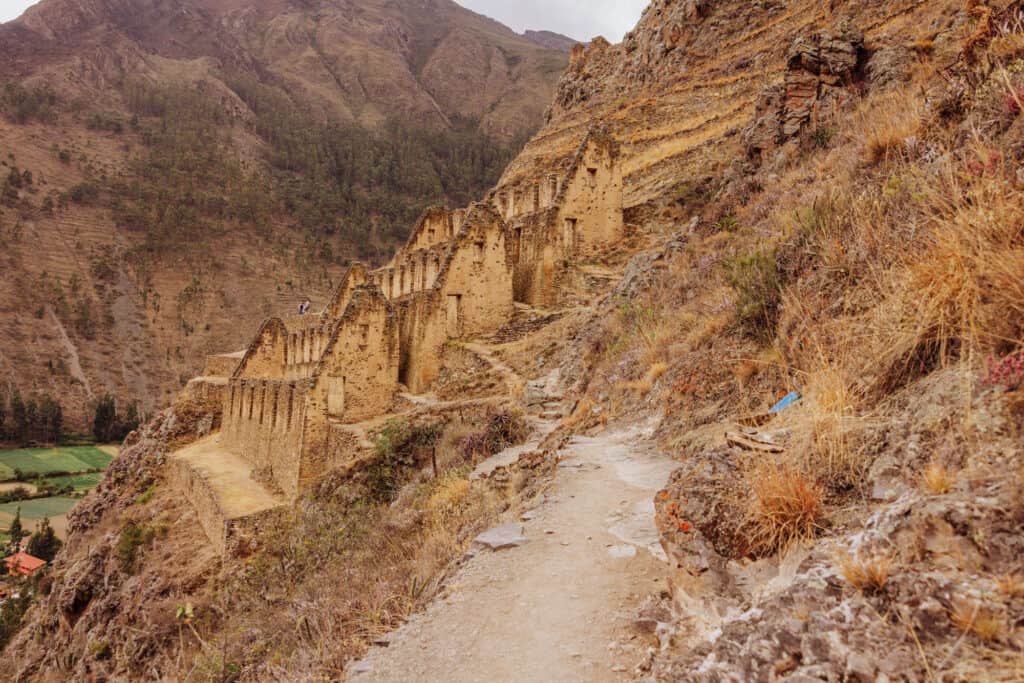
Wrap: Is it Worth Visiting Ollantaytambo From Cusco
You won’t regret making the easy trip from Cusco to Ollantaytambo. It’s really hassle-free if you hire a driver.
Visiting Ollantaytambo is like stepping back in time (several centuries). While it has modern conveniences and an efficient train station, the ruins and cobblestone streets are what you’ll remember.
While places like Moray and Maras are more stop-overs, Ollantaytambo is a destination that’s really worth spending a full day, or even a night, as you head to (or from) Machu Picchu.
